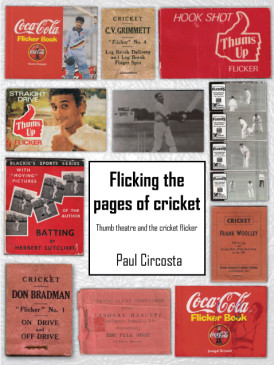Flicking The Pages of Cricket
Archie Mac |Published: 2017
Pages: 44
Author: Circosta, Paul
Publisher: Bookkeeper Publishing
Rating: 3.5 stars

You have to admire the determination and resilience of the cricket writer. Despite the rise of electronic books and an ever decreasing publishing market the cricket writer keeps producing interesting titles, many of which appeal to a niche market.
Paul Circosta is one such cricket writer, who specialises in the rarer subjects of cricket’s vast history. His previous works include Pinning Down Cricket Badges (reviewed on CW) and Australian and New Zealand Cricket Collector Cards Guide 1965 – 1995.
Circosta’s latest offering concerns the history of Flicker Books, or as Circosta informs us in the book, Thumb Theatre, as they are more descriptively known.
We learn that originally Flicker Books were produced as a training aid. Demonstrating different sporting techniques with cricket the first sport tackled. Some will know that Sir Donald Bradman – batting and Clarrie Grimmett – bowling, were the first flicker books published. What will be a surprise is that they were produced in England rather than Australia, with Grimmett and Bradman recruited while on an Ashes tour in 1930.
The author suggests Bradman and Grimmett were selected, rather than English cricketers, due to their dominance on the 1930 tour and also Grimmett’s knowledge of photography.
The initial Flicker Books were mass produced and sold for just sixpence. To increase profits the publisher allowed different advertisers to print their details on the covers. This, and the fact that sometimes different coloured covers were used makes obtaining all versions of the Bradman and Grimmett editions a challenge for the avid collector.
While Bradman and Grimmett remain the most popular and produced of the Flicker Books, there have been other subjects. Frank Woolley, Lindsay Hassett and Eddie Payter (one of the rarest Flicker Books) are some of the Anglo Australian cricketers to feature.
The country to move away from Flicker Books for just instructional purposes was India, which has a much more contemporary history of publishing Flicker Books. For those unfamiliar, Flicker Books are read both ways. That is usually one sequence of sequential images from front to back and another from back to front. The Indian soft drink companies, and later Coca Cola, had a player demonstrating a cricket skill one way and the featured player drinking the product in the reversed sequence.
To the author’s credit he keeps the entertaining history of Flicker Books moving at a brisk pace and intersperses his writings with numerous photos, many in colour. There is also a helpful appendix which lists the known Flicker Books publisher and another that provides details of the companies who advertised on the various editions of the Grimmett and Bradman versions.
While this little book should fall into a niche market, it is so well researched and produced it will no doubt, and deservedly, appeal to a wider market.






I am a great fan of co cola and cricket.
I would like to collect old co cola flicker books
Is it available? It refreshed my childhood memories. so o would like to collect that in period of 1998-2000
Comment by ARUN M A | 5:46pm BST 25 April 2020